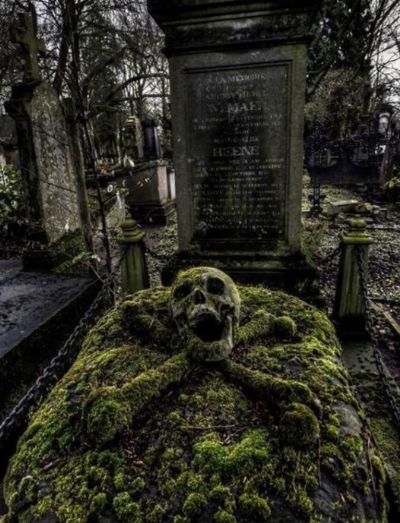Tombstones and graves
Most modern cultures mark the location of the body with a headstone. This serves two purposes. First, the grave will not accidentally be exhumed. Second, headstones often contain information or tributes to deceased. This is a form of remembrance for loved ones; it can also be viewed as a form of immortality, especially in cases of famous people’s graves. Such Monumental Inscriptions may subsequently be useful to genealogists and family historians.

There are multiple purposes to building a tomb, or just placing a tombstone. The one thought of most in recent times is for respect, but the original purpose of a tomb(stone) is just as likely to have been to hinder spirits in affecting the living. Tombstones may go back to the belief that ghosts may be “weighed down” (Turner, 124). The spirit would be bound to the tombstone, and be unable to affect the living. Many tombs, walled up with boulders and mounds of earth may have been for the same purpose (Turner, 124). Another purpose of tombs is to confuse the spirit. An example of this is placing a maze in the entrance (or exit, from the ghost’s point of view). This was believed to be very effective since it was also believed that ghosts can only travel in a straight line. Another way used to keep a ghost way was to build it a nice, comfortable “house” (Turner, 124).
Graves are usually grouped together in a plot of land called a cemetery or graveyard, and burials can be arranged by a funeral home, mortuary, undertaker or by a religious body such as a church or (for some Jews) the community’s Burial Society, a charitable or voluntary body charged with these duties. In some places this has created a land-use problem. For example, in Japan all people are cremated after death. About 10% of the arable land in China is taken up by graves
Graveyards or cemeteries can provide many insights into social history as well as providing places of contemplation and peacefulness. Throughout Europe, churchyards and cemeteries tend to be welcoming places, easily accessible and often open to view. Some are hidden behind high walls, other pride themselves on the landscaping that surrounds the gravesites. Cemeteries affirms the presence of the past and the continuance of life through untold generations.
These places are usually quiet and peaceful, the solemnity of the grave, the abondance of white stones covered with mossy hummocks and green vegetation provide us with a sense of peace that is in some ways a world apart from the hustle of everyday life and traffic.
While human societies have had disposed of their dead from the beginning, the burial of the corpse in a specific place is a relatively new phenomena. Even though we may look at the monuments like the Pyramids or the necropolis in Egypt, they were reserved to a handful of people believed to be of divine essence.
Before the XVth century, people were more frequently buried in churchyards, open fields, or family plots than in community cemeteries. The graves of most people went unmarked and only notables of the church and royalty were buried with identification. Early Christians were initially buried in their own cemeteries. As the Christian religion developed, a practice known as the cult of martyrs developed. Martyrs, who had died for their religion became saints and their remains were relics endowed with mystical virtues, so people demanded to be buried in churchyard. Churchyards were however rather small and soon became crowded to Church burial was becoming most unhealthy and in an effort to fit as many into the space as possible, corruption also became endemic as the bodies of the poor were squeezed into tiny spaces and their coffins disposed of as firewood.
The custom of burial in churchyards led to the development of charnel houses. The poor were initially buried in areas in the church yard or near the church. From time to time, the bones were dug up and then laid out in a tasteful and decorative manner in the charnel house. In other areas, this was done in catacombs. This enables the bones to kept safe by the church for the resurrection, but also released precious space in the church ground where others could be buried. Charnel houses were public places and an obvious reminder of the inevitability of death.
Much has been written about the cemetery of the city of Paris, Les Innocents, and how markets and open-air sermons, even festivals, were held before the porticoes in which the disordered bones were piled. The earth of Les Innocents, sanctified by the bodies of those child-saints, was held to fulfill the necessary ‘dust to dust’ clause within nine days. In 1785, the officials of Paris ordered the destruction of le Innocents upon public demand. A ‘mephitis’, or foulness was spreading in the air, it had started in the cellars of some houses directly next to the great burial pits, and steadily encroached upon neighboring areas. The work involved a massive dis-internment and removal of the bodies in the top layers of soil to quarries on the city’s outskirts. Bonfires were kept constantly alight to prevent infection, as the work proceeded for two Winters and an Autumn. The condition was nothing new; the air of les Innocents, which tarnished gold and rotted wood, had been remarked on for centuries. But the proximity of death was no longer required.
At Les innocents, there was a massive statue of Death which is now in the Louvre, a carven portal representing the tale of the three living and the three dead men, donated by the Duc de Berry as a burial fee, and under the porticos, the huge, anonymous frescoes of the dance macabre.
These frescoes, along with all other accoutrements of the great cemetery except the Death, are lost. The frescoes are known to us only by a book of woodcut prints published in 1485 in Paris, by the printer Guyot Marchant.
After the seventeenth century, the rise of the individual and the memory create the need for socially exclusive burial grounds. The fear of the spread of infectious diseases was another motivation to bring the growing population of the dead at outskirts of towns. They were soon proposed in those new cities called cemeteries along with a long-term if not eternal lease without the risk of being uprooted and stored in public with others. Gate-keepers, gardeners, grave diggers and other workers were required to ensure that every dead has its place and remains in peace. Between 1800 and 1806, big cities like Paris, Stockholm, and Vienna begin to build the large cemeteries that still exist today.
By the 1830’s cemeteries began to grow. While many poorer people continued to be buried in unmarked graves, there was a growth in elaborate mourning rituals and ornate tombstones. Another visual symbol of the mourning style of the Victorian era is the large mausoleums built in the new, beautifully landscaped, park-style cemeteries that began appearing. Some of these cemeteries tried hard to emulate a park-like environment, making a visit to the cemetery a more pleasant experience. The tombstone was often inscribed with many comments as several members of the one family may have been interred in a single site.
While it is said that death is the great leveler, difference in rank and class are often carried though to the grave. Some people spent extravagant sums of money to memorialize their loved ones in mausoleums or with artistic headstones in the form of a tree stump, a cherub, or other classic designs.
Cremation is a more recent phenomena. It became visible in the late XIXth century and it was long seen to be the preserve of the freethinker, the consciously modern and even the weird. In the USA, the growth of cremations has also been associated with a social change – the breakdown of family and community traditions and the decline in mainstream religious affiliation.
Special burials
Unmarked grave
In many cultures graves are marked with durable markers, or monuments, intended to help remind people of the buried person. An Unmarked Grave is a grave with no such memorial marker.
The phrase “unmarked grave” has metaphorical meaning in the context of cultures that mark burial sites. As a figure of speech, an unmarked grave represents consignment to oblivion, an ignominious end. As a monument is a sign of fondness or respect, similarly a grave with no marker is a sign of disdain and disrespect – representing an intent that the person be forgotten utterly.
The corpus of Pope Formosus was actually disinterred, placed on trial, found guilty, and ultimately thrown into an ‘unmarked grave’ — the waters of the River Tiber.
Anonymous burial
Another sort of unmarked grave is a burial site with an anonymous marker, such as a simple crucifix; boots, rifle and helmet; a sword and shield; a cairn of stones; or even lavish monuments. In this type of unmarked grave, no disrespect is intended. Rather, identification of the departed is impossible, yet it is desired that they be memorialized.
The United Kingdom has buried one of their unknown warriors in Westminster Abbey. France likewise honors an unknown soldier by burial underneath the Arc de Triomphe, Italy honors an unknown soldier in the Monumento al Milite Ignoto in Rome, and the Tomb of the Unknown Soldier, a monument in the U.S.’s Arlington National Cemetery is dedicated to American military personnel who have died without their remains being identified. These are extreme examples of anonymous graves, where the anonymity of the dead person is symbolic, indicating respect for all the unknown departed of war or calamity on a national scale.
Secret burial
In some very rare cases, a person will be buried without identification, even when their identity is known. In some cases of infamous or notorious figures, this is to avoid desecration of the corpse or vandalism of the site. In others it may be for exactly the opposite reason. Famous graves often become tourist attractions, or destinations of pilgrimage. To avoid this the family or friends honoring the dead might bury them in an unpublicized place, a secret location, or in a grave with a false name — or no name at all — on the marker.
Walt Disney was cremated and the ashes buried in a secret location — Forest Lawn Memorial Park Cemetery — one of many cemeteries that cater to the needs of famous dead people. Some burial sites at Forest Lawn, such as those of Humphrey Bogart and Mary Pickford, are secluded in private gated gardens, with no entry for the public. A number of tombs are also kept from the public eye. Forest Lawn’s Court of Honour advertises that in some of the crypts beneath it are spots which no amount of money can buy, but individuals may be “voted in” as “Immortals.” Out of respect for the privacy of the dead, no photographs taken at Forest Lawn are ever allowed to be published, and their information office usually refuses to say where famous people are buried.
Multiple bodies per grave
Some couples or groups of people want to be buried together, for example, a husband and wife. Since (in many cases) people die at different times, the exhumation of the first to die is often necessary. In other cases, the bodies may simply be buried side by side. Or if there were advanced planning the first person buried will be at a greater depth so that the second person can be buried on top at a shallower depth.
Mass burials
Mass burial is the practice of burying dozens, hundreds, or thousands of individuals in one massive pit, much like a landfill for human remains. Most cultures view mass burial as a way of objectifying corpses, and is often viewed as a form of gross disrespect to the individuals being buried. Civilizations attempting genocide often employ mass burial for the people they kill in the genocide, as it is mechanically efficient, and coincides neatly with their goals of dehumanizing and destroying a segment of the population.
However, in the case of mass disasters, or epidemics, mass burial is the only practical means of dealing with a number of corpses sufficient to overwhelm local resources.
In cases of mass burial, it is commonly of importance to survivors to later have the bodies exhumed, identified, and buried properly.
Animals burial
In addition to burying human remains, many human cultures also regularly bury animal remains. This is often necessary for hygienic reasons when the body cannot be disposed of in another way.
Pets and other animals of emotional significance are often ceremonially buried. Most families bury deceased pets on their own properties, mainly in a yard, with a shoe box or any other type of container served as a coffin. The Ancient Egyptians are known to have mummified and buried cats, which they considered deities.








